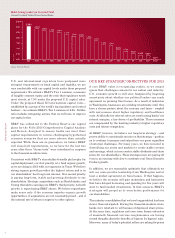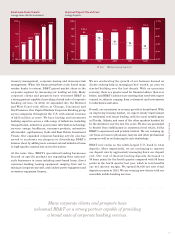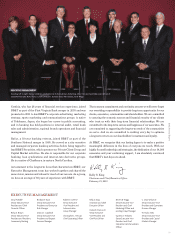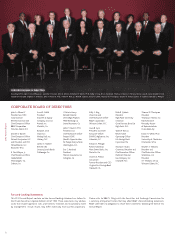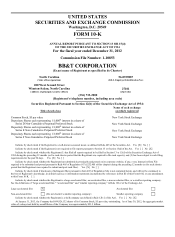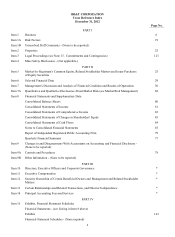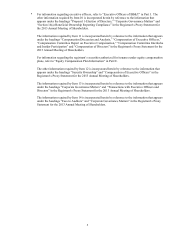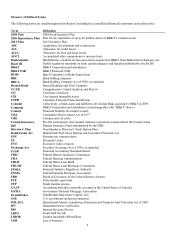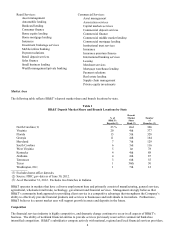BB&T 2012 Annual Report Download - page 20
Download and view the complete annual report
Please find page 20 of the 2012 BB&T annual report below. You can navigate through the pages in the report by either clicking on the pages listed below, or by using the keyword search tool below to find specific information within the annual report.2012 Annual Report
18
CONTINUE EXECUTION OF
RISK MANAGEMENT STRATEGIES
It is important to remember the causes of the deep recession that
have gripped our industry and our country: too much leverage and
too little diversification. Unfortunately, with signs of an improving
economy, some banks appear to be forgetting that costly lesson,
with excessively leveraged lending and higher-risk concentrations.
At BB&T, even though we could easily double our loan growth with
such actions, we are sticking with our disciplined lending strategy
and conservative long-term underwriting standards. We believe
there are ample opportunities to book loans that meet our rigorous
risk guidelines, while avoiding those transactions that may provide
a short-term boost in revenue but a long-term drag on earnings.
For example, one area of opportunity is increasing demand for multi-
family housing development as more Americans opt for renting an
apartment instead of buying a home. We are focusing on only those
projects that meet our parameters for cash flow and solid cash
equities. When the office market starts to recover, we will adhere
to our standards for pre-leases and good coverage ratios while
avoiding large syndicated office towers. For all commercial real estate
projects – an area that has been an excellent business for BB&T for
decades – we rely only on experienced lenders who are specifically
dedicated to understanding that market’s risk and rewards.
Over the last several years, BB&T has invested in analytical tools,
talent and training to make sure we better understand risk. We have
added Senior Risk Officers to help aggregate, integrate and correlate
all risks of the company. We have created an independent Credit
Risk Review program and a Consumer Risk Management function.
We have streamlined and automated systems to provide improved
financial information both internally and externally.
At the same time, we are diversifying BB&T’s balance sheet. On the
liability side, we have been working to improve our mix to emphasize
noninterest-bearing deposits. On the asset side, we have significantly
reduced our exposure to real estate, increasing commercial and industrial
loans, and focusing on specialized lending opportunities yielding higher
interest rates and margins. To diversify loan portfolio risk, we are
exploring new strategic lending opportunities such as agriculture.
MAINTAIN EXPENSE DISCIPLINE
We believe that controlling what can be controlled is essential at all times,
especially so in volatile or uncertain times. Expense control is a prime
example. Throughout the last five difficult years and continuing in 2013,
we have been and will be relentless in maintaining expense discipline.
Our tight budgeting is reflected in BB&T’s efficiency ratio, which
measures expenses as a percentage of revenues, so lower percentages
signal improved performance. Our ratio of 54.3% for 2012 is down
from a year earlier, and compares very favorably with our peer
average of 63.8%, which increased in 2012.
We decrease expenses wherever possible. Consistent with our
improving credit quality, foreclosed property expenses are at the
lowest level since 2007. With the completion of the BankAtlantic
acquisition in 2012, we have reduced our merger-related and
restructuring expenses. In 2013, we expect expenses independent
of immediately accretive revenue to be down by 1% to 2%.
Our wide-ranging “re-conceptualization project,” where we
challenged BB&T’s leaders to design more efficient ways to run their
businesses, started showing results in 2012, with more to come in
2013. For example, we have cut BB&T’s vendor payments for paper
checks by 90% through automation.
As a result of our day-to-day tight management of discretionary
expenses, BB&T avoids drastic cost-cutting programs. Those
draconian cuts may win headlines, but they undermine a company’s
relationship with their employees, and are contrary to the strong
value proposition we have with our associates.
Rather, to use a football analogy, we believe expense control is
a “ground game” rather than a “Hail Mary pass,” where we constantly
look for opportunities to reduce expenses, especially those that do not
create near-term revenue opportunities. For example, we only take on
projects with quick payback periods, typically less than three years. We
centralize, standardize and automate wherever possible. To effectively
centralize sourcing and procurement, we arm BB&T’s business leaders
with more detailed budgets as they plan and operate their businesses.
THANK YOU
In closing, I want to recognize and introduce some extraordinary
individuals. Some have provided wise guidance to BB&T for many
years, while others will help lead us as we build on our remarkable
141-year histor y.
We are matching the membership of the boards of BB&T and our
largest subsidiary, Branch Banking and Trust Company, which will
give us more flexibility and is in line with the structure of many of our
peer banks. As part of that change, which was effective December 31,
2012, the number of corporate directors was increased from 15 to 19 and
the two boards will have identical memberships. At the same time, three
members of the corporate board and three members of the bank board
retired in accordance with our policy of directors retiring at age 70.
I want to express my deepest appreciation to our retired directors:
J. Littleton Glover Jr., Jane P. Helm and Valeria Lynch Lee on the
corporate board and Thomas K. Ferguson, Donald N. Patten and David
W. Smith Jr. on the bank board. With a combined 74 years of service
as directors, they have contributed immensely to BB&T’s success.
I also would like to welcome seven new members of the corporate board,
all from the Branch Banking and Trust board: James A. Faulkner,
Dahlonega, Georgia; I. Patricia Henry, Stone Mountain, Georgia; Eric
C. Kendrick, Arlington, Virginia; Louis B. Lynn, Columbia, South
Carolina; Edward C. Milligan, Marietta, Georgia; Charles A. Patton,
Hopewell, Virginia; and Tollie W. Rich Jr., Cape Coral, Florida.
Our lead director is Ronald E. Deal, who has served on BB&T’s board
since 1986 and is chairman of Wesley Hall Inc. in Hickory, North
Carolina. He replaced Jane Helm after her retirement.
Also in 2012, we added two members to BB&T’s Executive Management
team. Cynthia Williams, chief corporate communications officer,
and Rufus Yates, president and CEO of BB&T Securities (formerly
Scott & Stringfellow) and manager of our Capital Markets Corporate
Banking group, joined the 10 existing members on the team that sets
policy and direction for BB&T.


